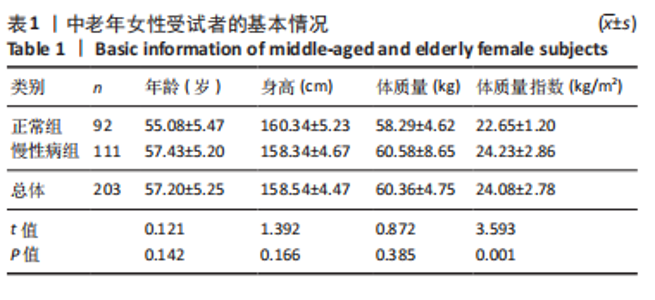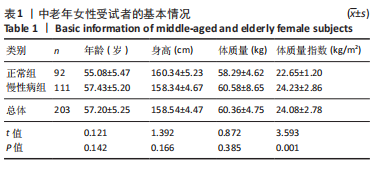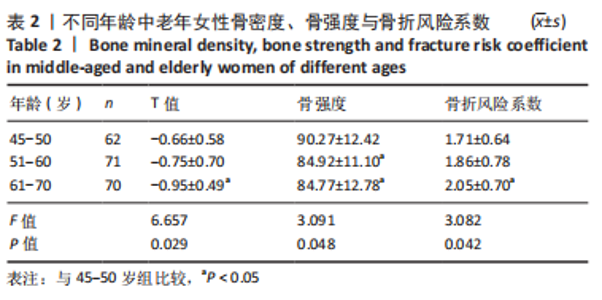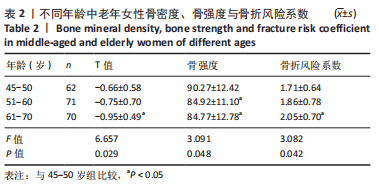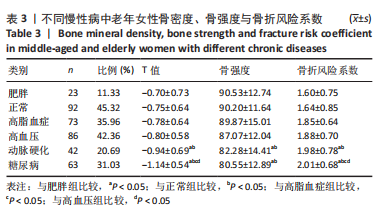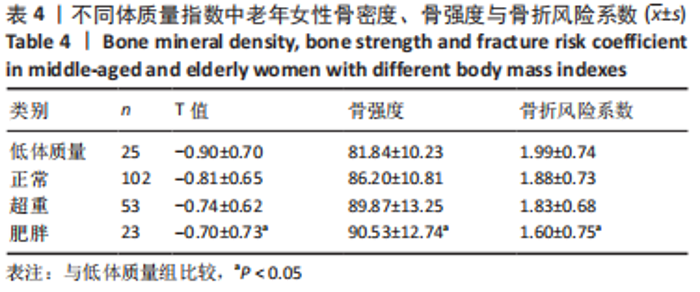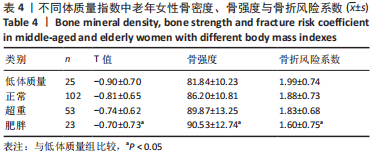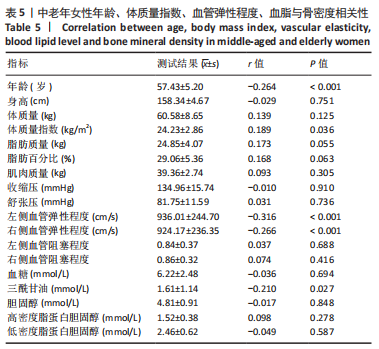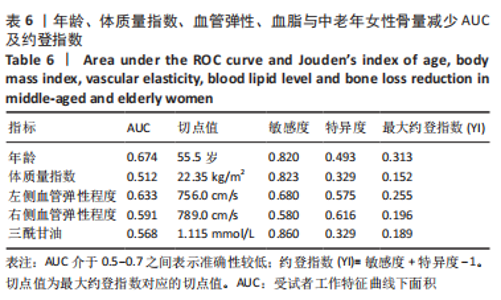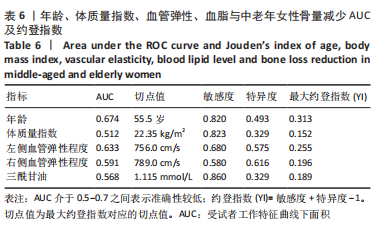[1] 中华医学会 中华医学会杂志社,等.原发性骨质疏松症基层诊疗指南(2019年)[J].中华全科医师杂志,2020,23(4):304-315.
[2] 中华医学会风湿病学分会.糖皮质激素诱导的骨质疏松诊治的专家共识[J].中华风湿病学杂志,2013,17(6):363-368.
[3] 崔新雯,张一民,王彦桃,等.未绝经女性骨量减少风险自评估方法的建立[J].北京体育大学学报,2016,39(3):66-72.
[4] 中国健康促进基金会基层医疗机构骨质疏松症诊断与治疗专家共识委员会.基层医疗机构骨质疏松症诊断和治疗专家共识(2021)[J].中国骨质疏松杂志,2021,27(7): 937-944.
[5] 吴健,周涛,俞兵,等.血脂与老年女性骨质疏松性骨折的相关研究[J].实用骨科杂志,2021,27(2):127-130.
[6] 郑应麟.中老年2型糖尿病患者低骨量与甲状腺激素水平的相关分析[D].南昌:南昌大学,2018.
[7] 苟静,岳建彪,李霞.70岁以上老年人群骨质疏松症与心血管疾病危险因素的关系研究[J].中国医学前沿杂志(电子版),2021,13(5):70-73.
[8] 熊义博,刘学员,邓泽熙,等.老年人骨质疏松与动脉硬化的关系[J].医学信息, 2019,32(19):106-108.
[9] 于婷婷,黄娜娜,苏娇,等.颈动脉和下肢动脉粥样硬化分级与2型糖尿病患者骨密度的关系[J].中国骨质疏松杂志,2019,25(8):1052-1058.
[10] CHIN KY, IMA-NIRWANA S. Calcaneal quantitative ultrasound as a determinant of bone health status:what properties of bone does it reflect? Int J Med Sci. 2013;10(12):1778-1783.
[11] 岳亚杰. 吉林省德惠市658名中老年女性跟骨超声骨密度分析[D].长春:吉林大学,2016.
[12] 李悦,夏俊,张敏,等.脉搏波传导速度评价动脉粥样硬化性疾病的应用进展[J].中国动脉硬化杂志,2021,29(3):271-276.
[13] 黄薇,王宏宇,刘金波,等.下肢动脉硬化闭塞症患者踝肱指数与冠状动脉狭窄程度的相关性研究[J].心肺血管病杂志,2022,41(7):754-756+767.
[14] 汪宏莉,韩延柏,陈涛,等.老年人高血压风险预测肥胖指标筛选[J].中国公共卫生,2020,36(1):105-109.
[15] 陈宏杰. 中国绝经后女性的初潮年龄和绝经年龄与糖尿病、心血管疾病和骨质疏松的相关性研究[D].福州:福建医科大学,2013.
[16] 屈敏.女性绝经后骨质疏松发生的相关影响因素及预防管理措施[J].临床医学, 2022,42(8):49-51.
[17] 吴永君,张维森,周柏靖,等.自然绝经年龄与绝经后肥胖关系[J].中国公共卫生, 2022,38(12):1544-1548.
[18] 李薇,张博,张雨薇等.雌激素调节骨代谢作用的研究进展[J].中国骨质疏松杂志, 2017,23(2):262-266.
[19] INGE G, CHAN R,JEAN W, et al. A combined nutrition and exercise intervention influence serum vitanmin B-12 and 25-Hydroxyvitamin D and bone turnover of healthy chinese middle-aged and older adults. J Nutr. 2020;150(8):2112-2119.
[20] 孙楠,李纳,李小玲,等.某医院体检人群骨密度情况及骨量异常患病率研究[J].风湿病与关节炎,2022,11(8):13-16+22.
[21] 常晓宇,邓颖,何君,等.2018年四川省40岁及以上人群骨质疏松症现况分析[J].预防医学情报杂志,2022,38(6):769-776.
[22] 饶淑梅,田蓉.老年人骨密度T值与生活方式的相关性分析[J].中国当代医药, 2022,29(28):159-162.
[23] 贾桠钧.老年男性2型糖尿病患者骨质疏松调查及与体质量指数、糖化血红蛋白、病程和肾功能关系研究[J].中国骨质疏松杂志,2020,26(1):75-78.
[24] 俞海燕,郭晓珍,黄文龙,等.2型糖尿病患者FRAX评分及骨密度与BMI的相关性分析[J].中国骨质疏松杂志,2017,23(6):761-763+767.
[25] 栗敏,郭勇.北京南郊地区成年人桡骨远端骨密度及FRAX骨折风险评分与BMI的相关分析和探索研究[J].中国骨质疏松杂志,2018,24(8):1049-1053+1092.
[26] 袁嘉尧,林燕平,林贤灿,等.绝经后女性体质量指数、体成分与骨密度的变化特征及关系[J].中国骨质疏松杂志,2022,28(6):830-835.
[27] 邓红.广州市30-49岁女教师骨质与营养状况的相关性分析[J].中国组织工程研究, 2018,22(4):499-504.
[28] 王聪,唐海英,李建中.高龄老人慢性病与骨质疏松症的相关性研究进展[J].中国骨质疏松杂志,2018,24(6):831-835.
[29] 张海洋,陈春霞,李慧蓉.南京市江宁区老年人骨密度现状分析[J].江苏预防医学, 2018,29(1):70-71.
[30] 倪利华.糖尿病性骨质疏松症的研究进展[J].临床与病理杂志,2020,40(7):1897-1901.
[31] 中华医学会糖尿病学分会.中国2型糖尿病防治指南(2020年版)[J].中华糖尿病杂志,2021,13(4):315-409.
[32] SCHILLERUP SP, SKOV-JEPPESEN K, WINDELOV JA, et al. Gut hormones and their effect on bone metabolism. potential drug therapies in future osteoporosis treatment. Front Endocrinol(Lausanne). 2019;10(2):75.
[33] AVOGARO A, FADINI GP. Microvascular complications in diabetes:A growing concern for cardiologists. Int J Cardiol. 2019;291(9):29-35.
[34] ASDIPOOYA K,UY EM. Advanced glycation end products(AGEs), Reception for AGEs,diabetes,and bone:review of the literature. Endocr Soc. 2019;3(10):1799-1818.
[35] LECKA-CZERNIK B,BAROI S, STECHSCHULTE LA, et al. Marrow fat a new target to treat bone diseases? Curr Osteoporos Rep. 2018;16(2):123-129.
[36] 邓静,冯正平.降糖药对骨代谢的影响[J].中华骨质疏松和骨矿盐疾病杂志,2015, 8(3):256-260.
[37] 王亚丽,张乌云.探讨老年人骨质疏松与动脉硬化风险之间的关系[J].中国骨质疏松杂志,2017,23(3):346-349.
[38] 黄喜顺,邱耀辉,吴义森,等.中老年人骨质疏松与颈动脉硬化斑块形成的关系初探[J].现代中西医结合杂志,2014,23(26):2921-2923.
[39] YAMAGUCHI T,SUGIMOTO T, YANO S, et al. Plasma lipids and osteoporosis in postmenopausal women. Endoer J. 2002;49(2):211-217.
[40] 韩栋,卢晓栋,王奔,等.骨质疏松性骨折与高血压病相关性分析[J].继续医学教育,2020,34(7):85-87. |
